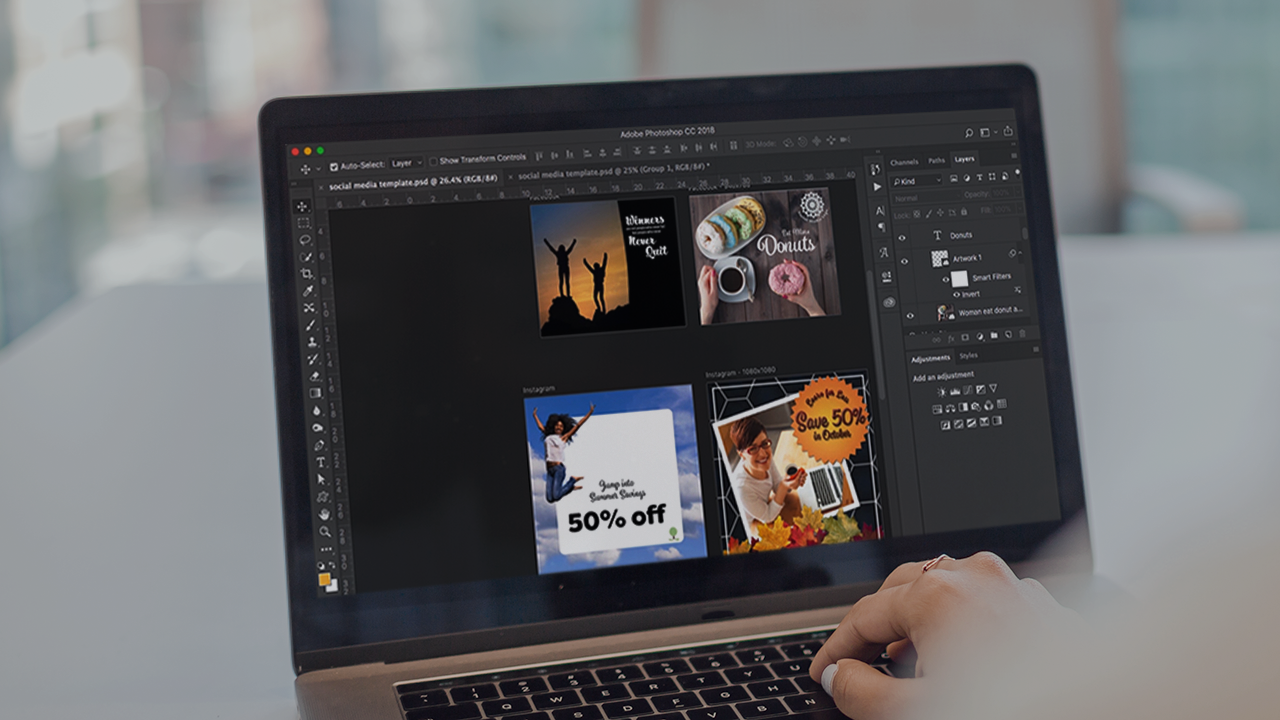The contemporary digital landscape is characterized by rapidly diminishing attention spans, and the potency of captivating visuals has emerged as an indispensable tool for capturing and retaining viewer interest.
This sophisticated platform empowers users to craft visuals that not only captivate and resonate with audiences but also serve as a catalyst for elevating their virtual presence.
Within this discourse, we will discuss a comprehensive exploration of Photoshop CC, delving into its diverse arsenal of Photoshop tools, providing insights into instructive tutorials, elucidating essential Photoshop system requirements, and guiding prospective users through the process of software acquisition, encompassing download options, subscription models, and pricing considerations.
Table of Contents
Getting Started with Photoshop CC
Adobe Photoshop CC is a sophisticated and adaptable image editing program that offers a plethora of tools and features to help you in creating visually amazing pictures for your social media presence. Getting started with this can be both thrilling and gratifying, whether you’re new to Photoshop or trying to improve your abilities.
Familiarizing Yourself with the Interface
When you first launch the software, you’ll encounter a user-friendly interface with various panels, tools, and options. Take a moment to explore the interface and get acquainted with the main components, such as the Toolbar, Options Bar, Layers Panel, and Color Picker. Customizing your workspace can significantly improve your workflow. Arrange panels and tools to suit your preferences, and save your custom workspace for future use.
Understanding Layers
Layers are at the heart of Photoshop’s functionality. They allow you to stack and organize different elements of your design separately, enabling you to make precise adjustments and edits. Think of layers as transparent sheets that you stack on top of each other to create your final image. As you create and manipulate elements in your design, each new element is typically placed on a new layer. This layer-based approach provides flexibility and control over your creative process.
Basic Tools and Functions
It has a number of tools to help you create and modify graphics. The Marquee and Lasso Tools for selecting and cropping, the Brush Tool for painting and creating effects, the Text Tool for adding text to your designs, and the Move Tool for arranging objects within your canvas are all vital tools for social media design.
Undo and History
Mistakes happen, and this software offers multiple ways to correct them. The “Undo” command (Ctrl/Cmd + Z) is your immediate way to reverse your last action. Additionally, the History Panel keeps track of your recent actions, allowing you to step back through your editing process to a specific point in time. This feature is particularly handy when experimenting with different design ideas.
Online Resources and Tutorials
Learning Photoshop CC is an ongoing process, and there are countless online resources available to help you along the way. Adobe offers official tutorials and guides to help you learn the software’s features step by step. You can also explore YouTube tutorials, online courses, and community forums where fellow designers share tips, tricks, and insights. Taking advantage of these resources can accelerate your learning curve and boost your confidence as you dive into more advanced techniques.
Practice and Experimentation
Like any skill, proficiency in Photoshop CC comes with practice and experimentation. Don’t be afraid to try new tools, experiment with different effects, and explore creative possibilities. Create mock projects, experiment with various design elements, and push your creative boundaries. Over time, you’ll develop your own unique style and gain a deeper knowledge of how to leverage the software’s capabilities for your social media visuals.
Design Principles for Social Media Visuals
Creating visually appealing and impactful social media visuals requires a solid understanding of design principles. These principles guide your creative decisions, ensuring that your visuals effectively communicate your message, engage your audience, and leave a lasting impression.
Color Psychology and Selection
Colors elicit emotions and influence how your audience views your material. Colors should be chosen to complement your brand’s identity and the message you wish to express. Consider the psychological consequences of various hues, such as blue, which may conjure trust and professionalism, and red, which can elicit enthusiasm and desire. Maintain a color palette that is agreeable to your target audience and improves the overall mood of your pictures.
Typography and Font Choice
The choice of fonts can significantly impact the readability and visual appeal of your social media visuals. Select fonts that reflect your brand’s personality and are legible across various devices and screen sizes. Pair complementary fonts – one for headlines and another for body text – to create a visually pleasing hierarchy. Experiment with font sizes, weights, and styles to emphasize key messages and maintain a consistent visual identity.
Composition Techniques for Social Media Graphics
Visuals that are well-composed catch attention and direct the viewer’s eye through the material. To produce balanced and visually attractive designs, use composition principles like the rule of thirds, leading lines, and symmetry. Use negative space to add clarity and attention to your main subject. Keep the platform dimensions in mind to ensure that your graphics are suited for each social media outlet.
Incorporating Brand Identity into Visuals
Consistency is key to building brand recognition. Infuse your brand’s identity into your visuals through the use of logos, colors, and design elements that reflect your brand’s personality. Create a visual style guide that outlines guidelines for fonts, colors, logo usage, and image treatments. When users encounter your visuals, they should instantly recognize your brand and associate it with a specific tone and message.
Balancing Visual Elements
Achieve balance in your social media visuals by distributing visual elements evenly throughout the design. Balance can be symmetrical or asymmetrical, so long as the effect you want to create. Distribute text, images, and graphics in a way that avoids clutter and ensures a pleasing visual experience. Pay attention to the visual weight of different elements and adjust their placement accordingly.
Visual Hierarchy and Focal Points
Guide the viewer’s gaze by establishing a clear visual hierarchy. Highlight the most important information through size, color, and placement. Create focal points in your design to call attention to key aspects of your design. Make sure the focal point properly delivers the required message, whether it’s a call-to-action button, a headline, or an image.
Experimenting with Contrast and Texture
Contrast adds visual interest and helps elements stand out. Experiment with contrast in terms of color, size, and typography to create dynamic visuals. Texture can add depth and tactile appeal to your designs. Consider incorporating subtle textures that complement your brand’s identity and enhance the overall visual experience.
Editing and Enhancing Photos for Social Media
Visual content is a driving force behind social media engagement. High-quality and visually appealing photos can significantly impact your online presence, helping you connect with your audience and convey your brand’s message effectively. In this section, we’ll delve into the art of editing and enhancing photos specifically for social media, covering techniques that will elevate your visuals and make them stand out in the crowded digital landscape.
Adjusting Lighting and Exposure
Lighting plays a crucial role in photography. If your original photo is underexposed or overexposed, adjust the exposure levels to ensure proper brightness and clarity. Use tools like brightness, contrast, and level adjustments to fine-tune the lighting and bring out the details in your image.
Color Correction and Enhancement
Colors set the mood and tone of your photos. Correct any color imbalances and enhance the vibrancy of your images. Use tools like the Color Balance and Hue/Saturation adjustments to fine-tune the colors and make them pop. Be careful not to over-saturate or oversaturate, as this can lead to unnatural-looking visuals.
Retouching and Removing Imperfections
Retouching can assist in improving the overall appearance of your photographs. To eliminate blemishes, wrinkles, and other flaws, use the Healing Brush or Clone Stamp tool. Be careful not to overdo it – the idea is to improve the shot while keeping it seeming genuine.
Applying Filters and Effects
Filters and effects may lend a distinctive touch to your images, resulting in a consistent and appealing visual style. Experiment with Instagram-like filters, vignettes, and creative effects that are consistent with the identity of your company. However, be sure that the filters and effects you choose complement the shot rather than overpower it.
Cropping and Framing
Cropping is a powerful tool for focusing the viewer’s attention on the subject of your photo. Consider the very famous rule of thirds and other compositional guidelines to create a well-balanced composition. Crop out any distracting elements that don’t contribute to the main message of the photo.
Resizing for Different Platforms
Each social media platform has specific image dimensions and requirements. Resize your photos to match the platform you’re posting on. This ensures that your visuals display properly and maintain their quality on all devices. For example, Instagram posts and stories have different aspect ratios, so it’s essential to tailor your images accordingly.
Adding Text and Graphics
To convey messages or promotions, consider adding text or graphics to your photos. Ensure that the text is legible, complements the visual, and aligns with your brand’s typography. Graphics, such as icons or logos, can enhance the overall message and help reinforce your branding.
Balancing Realism and Creativity
While enhancing your photos, strike a balance between realism and creativity. Enhancements should enhance the photo’s visual appeal without distorting reality. Keep in mind that authenticity resonates with audiences, so be cautious about going overboard with edits.
Saving in Web-Friendly Formats
Once your photo is edited to perfection, save it in a web-friendly format, like JPEG or PNG. These formats maintain a good balance between image quality and file size, ensuring that your photos load quickly on social media platforms.
Advanced Techniques for Impactful Visuals
As you gain confidence in your design skills, exploring advanced techniques can take your social media visuals to the next level. These techniques allow you to create visually stunning and impactful content that stands out in the competitive online landscape.
Creating GIFs and Animations
GIFs and animations add dynamic elements to your visuals, capturing attention and conveying messages in a captivating way. Use Photoshop’s timeline feature to create simple animations, such as animated text, product demos, or eye-catching transitions. GIFs can be used to showcase product features, share how-to guides, or simply add an element of fun to your content.
Adding Textures and Overlays
Textures and overlays can give your visuals depth, character, and a unique visual style. Experiment with overlays like gradients, patterns, or transparent textures to add subtle effects to your images. Overlays can be used to create vintage or grunge looks or even to simulate lighting effects, adding a touch of sophistication to your visuals.
Designing Eye-Catching Collages
Collages allow you to combine multiple images into a single composition, telling a more comprehensive story. Arrange images creatively to evoke emotions, showcase different aspects of a product, or highlight various elements of your brand. Collages can be a fantastic way to provide a snapshot of your brand’s versatility and offerings in a single visual.
Utilizing Layer Styles and Blending Modes
Layer styles and blending modes offer a wide range of creative possibilities. Experiment with drop shadows, glows, bevels, and gradients to supply depth and dimension to your elements. Blending modes can create interesting effects by combining layers in unique ways, such as creating a vintage look or blending text into a background image seamlessly.
Incorporating Parallax Effect
By moving distinct layers at varying rates, the parallax effect provides the appearance of depth. While this effect is often utilized in online design, it may also be employed in social media graphics. Scrolling or swiping design features may engage consumers and give a more engaging experience, encouraging them to explore your information deeper.
Manipulating Perspective and Distortion
Experiment with perspective distortion to create visual interest and unique compositions. Using tools like the Perspective Warp feature in Photoshop, you can adjust the perspective of objects within an image to create dramatic and dynamic effects. This technique can be particularly effective for architectural or product photography.
Embracing Minimalism and Negative Space
Incorporate the principles of minimalism and negative space to create visually impactful compositions. By simplifying your design and utilizing empty spaces, you can draw attention to your main subject and convey a sense of elegance and sophistication. Minimalism can be particularly effective in conveying a clear and focused message.
Combining Photography and Graphics
Fuse photography with graphic elements to create unique visuals that seamlessly blend the real world with creative design. Incorporate vector graphics, icons, or illustrations into your photos to enhance storytelling and add visual interest. This technique can bring a harmonious balance between the familiar and the imaginative.
Workflow Tips and Time-Saving Tricks
Efficiency is crucial in the fast-paced world of social media content creation. Streamlining your workflow and employing time-saving tricks can help you produce high-quality visuals more effectively and consistently. Here are the various workflow tips and tricks that will boost your productivity and make the process of creating social media visuals smoother and more efficient.
Utilize Templates and Presets
Templates and presets are pre-designed layouts or styles that you can reuse for different projects. Create templates for common social media graphics, such as posts, stories, and banners. Having a set of well-designed templates saves you time and ensures brand consistency. Customize the templates with relevant text and images to suit each specific post.
Keyboard Shortcuts for Efficiency
Mastering keyboard shortcuts can greatly make your workflow easier. Familiarize yourself with essential shortcuts in Photoshop CC to quickly access tools, perform actions, and navigate through the software. For example, “Ctrl/Cmd + C” copies, “Ctrl/Cmd + V” pastes, and “Ctrl/Cmd + T” transforms selected elements.
Batch Processing
If you’re working on multiple images with similar adjustments, consider using batch processing. It allows you to apply the same edits to a group of images simultaneously, saving you time and ensuring consistency across your visuals.
Use Smart Objects
Smart Objects are layers that preserve the original content and allow you to make non-destructive edits. Convert layers to Smart Objects before applying filters or transformations. This way, you can always go back and fine-tune your adjustments without affecting the original image quality.
Create Action Scripts
Photoshop CC’s Action feature records a sequence of steps and allows you to replay them with a single click. Create action scripts for repetitive tasks, such as resizing images, adding specific effects, or applying filters. This automation can save you significant time when editing multiple visuals.
Streamline Layer Organization
Organize your layers logically to prevent confusion and make edits more efficient. Group related layers together and use descriptive names to identify their contents. You can also collapse groups to focus on specific sections of your design, making it easier to navigate through complex compositions.
Save Custom Brushes and Styles
If you frequently use specific brushes, gradients, or layer styles, save them as presets for easy access. Custom brushes can add unique textures or effects to your designs, while layer styles can provide consistency in your branding elements.
Use Libraries and Cloud Storage
Adobe Creative Cloud offers Libraries, which allow you to store and access assets like graphics, logos, and color swatches across different projects. Cloud storage ensures your files are accessible from any device, enabling you to seamlessly switch between devices without worrying about file transfers.
Plan and Batch Content Creation
Set aside specific time slots for content creation and batching. Create multiple visuals in one sitting, so you can maintain a consistent posting schedule without interrupting your workflow. Planning and batching content minimizes distractions and allows you to focus on creativity during dedicated sessions.
Invest in High-Quality Assets
High-quality stock photos, graphics, and design assets can save you time and enhance your visuals. Invest in reputable stock image websites or design marketplaces to access a wide range of assets that align with your brand’s style.
Conclusion
Adobe Photoshop CC equips you with the tools to create captivating visuals that enhance your social media presence. Armed with an understanding of design principles, a mastery of Photoshop CC’s features, and a commitment to staying current with design trends, you can craft visuals that leave a lasting impression. Elevate your online presence, engage your audience, and stand out in the competitive world of social media by harnessing the creative power of Photoshop CC at www.2beshop.com. Your journey to creating eye-catching visuals starts here.












